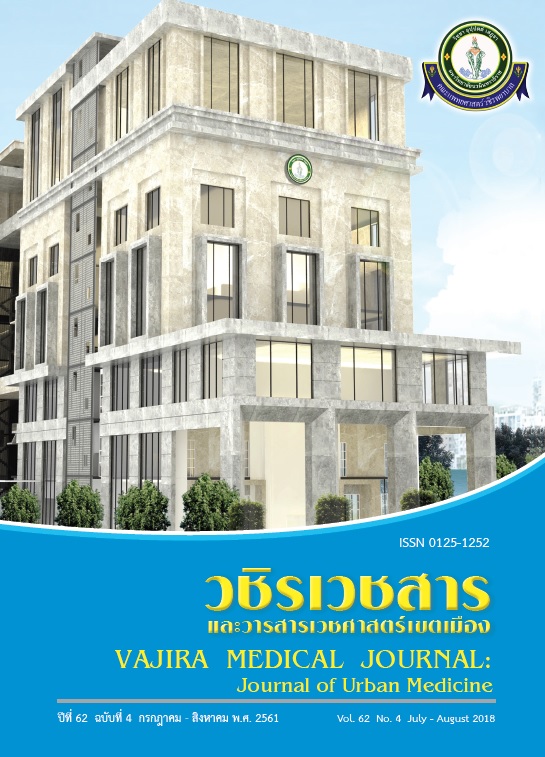Immobilization of Forearm Rotation: Sugar Tong Splint Versus Volar-dorsal short Arm Splint
Main Article Content
Abstract
Objective: To compare forearm rotation allowed by sugar tong splint and volar-dorsal short arm splint in normal healthy persons
Methods: A total 32 volunteers (16 men and 16 women) were recruited. The active pronation and supination of the right forearm in 90 degree elbow flexion without any immobilization were measured with digital goniometer both before and after applying the sugar tong splint. The proximal part of sugar tong splint was cut to convert into a volar-dorsal splint. Active forearm rotation with volar-dorsal splint was measured.
Results: Sugar tong splint allowed limitation of forearm pronation and supination by 89.5% and 81% Volar-dorsal short arm splint allowed limitation of forearm pronation and supination by 67% and 58%. There was significant difference in active forearm pronation or supination between sugar tong splint and volar-dorsal splint in men and women (p<0.001).
Conclusions: There was significant difference in the active forearm rotation between sugar tong splint and volar-dorsal splint. The sugar tong splint limits forearm rotation superior to volar-dorsal splint. However, the efficiency of volar-dorsal splint might not be practically different from the sugar tong splint for patients with mild degree fractures of the distal end of radius who may be satisfied with volar-dorsal splint. Therefore, a future study may need to be conducted to compare the application of the sugar tong splint with the volar-dorsal splint.
Downloads
Article Details
References
2. Kim JK, Kook SH, Kim YK. Comparison of forearm rotation allowed by different types of upper extremity immobilization. J Bone Joint Surg Am. 2012;94(5):455-60.
3. Kim JK, Park ES. The effect of short arm cast length on forearm rotation. J Hand Surg Am. 2014;39(4):629-33.
4. Trocchia AM, Elfar JC, Hammert WC. Biomechanical measurements of forearm pronosupination with common methods of immobilization. J Hand Surg Am. 2012;37(5):989-94.
5. Bong MR, Egol KA, Leibman M, Koval KJ. A comparison of immediate postreduction splinting constructs for controlling initial displacement of fractures of the distal radius: a prospective randomized study of long-arm versus short-arm splinting. J Hand Surg Am. 2006;31(5):766-70.
6. Slaughter A, Miles L, Fleming J, McPhail S. A comparative study of splint effectiveness in limiting forearm rotation. J Hand Ther. 2010; 23(3):241-7.
7. McAdams TR, Spisak S, Beaulieu CF, Ladd AL. The effect of pronation and supination on the minimally displaced scaphoid fracture. Clin Orthop Relat Res. 2003(411):255-9.
8. DiTano O, Trumble TE, Tencer AF. Biomechanical function of the distal radioulnar and ulnocarpal wrist ligaments. J Hand Surg Am. 2003;28(4): 622-7.
9. Xu J, Tang JB. In vivo changes in lengths of the ligaments stabilizing the distal radioulnar joint. J Hand Surg Am. 2009;34(1):40-5.
10. Stuart PR, Berger RA, Linscheid RL, An KN. The dorsopalmar stability of the distal radioulnar joint. J Hand Surg Am. 2000;25(4):689-99.
11. Jung JM, Baek GH, Kim JH, Lee YH, Chung MS. Changes in ulnar variance in relation to forearm rotation and grip. J Bone Joint Surg Br. 2001; 83(7):1029-33.
12. King GJ, McMurtry RY, Rubenstein JD, Gertzbein SD. Kinematics of the distal radioulnar joint. J Hand Surg Am. 1986;11(6):798-804.
13. Sarmiento A, Pratt GW, Berry NC, Sinclair WF. Colles' fractures. Functional bracing in supination. J Bone Joint Surg Am. 1975;57(3):311-7.
14. Grafstein E, Stenstrom R, Christenson J, Innes G, MacCormack R, Jackson C, et al. A prospective randomized controlled trial comparing circumferential casting and splinting in displaced Colles fractures. CJEM. 2010;12(3):192-200.
15. Tumia N, Wardlaw D, Hallett J, Deutman R, Mattsson SA, Sanden B. Aberdeen Colles' fracture brace as a treatment for Colles' fracture. A multicentre, prospective, randomised, controlled trial. J Bone Joint Surg Br. 2003; 85(1):78-82.


